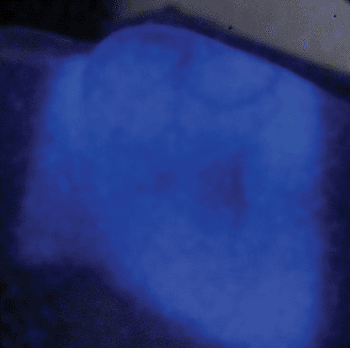Cherenkov Effect Breakthrough Allows Clinicians to Visualize Radiotherapy in Body
|
By MedImaging International staff writers Posted on 05 Feb 2014 |

Image: Long exposure image of Cherenkov emission and induced fluorescence from fluorescein dissolving in water during irradiation from a therapeutic LINAC (linear particle accelerator) beam (Photo courtesy of Dartmouth engineering PhD candidate Adam Glaser).

Image: A radiation beam treatment is visualized here in the first in human use of the technique. The blue represents the treatment area. As the dose fades, the treatment area becomes a dark gray shadow (Photo courtesy of Dartmouth University).
A scientific breakthrough may provide radiation oncologists with new tools to increase the accuracy and safety of radiation treatment in cancer patients by helping them visualize the powerful beams of a linear accelerator as they enter or exit the body.
Dartmouth University (Hanover, NH, USA) began to study a scientific phenomenon called the Cherenkov Effect in 2011. The scientists and engineers hypothesized that by using Cherenkov emissions the beam of radiation could be “visible” to the treatment team. The capability to seize a beam of radiation would show: how the radiation signals move through the body, the dose of radiation to the skin, and any errors in dosage.
Scientists, for the first time in humans, have used the technology, and the first case was a female breast cancer patient undergoing radiation. “Breast cancer is suited for this because the imaging visualizes the superficial dose of radiation to the skin,” said Lesley A. Jarvis, MD, radiation oncologist, Norris Cotton Cancer Center. Similar to sunburn, skin reactions are a typical and annoying side effect during breast radiation. “By imaging and quantitating the surface dose in a way that has never been done before,” said Dr. Jarvis, “we hope to learn more about the physical factors contributing to this skin reaction.”
By seeing the effect of radiation on the body, Dartmouth’s Norris Cotton Cancer Center radiation oncologists and physicists can make adjustments to avoid side effects to the skin. Most radiation patients undergo somewhere between 8–20 sessions. The Cherenkov images of the breast cancer patient showed a hot spot in her underarm, which physicians and physicists could work to prevent in future sessions. “The actual images show that we are treating the exact correct location, with the appropriate beam modifications and with the precise dose of radiation,” stated Dr. Jarvis.
This trial revealed that the Cherenkov Effect is feasible for use real-time during radiation. “We have learned the imaging is easy to incorporate into the patient's treatment, adding only minimal time to the treatments,” said Dr. Jarvis.
This was the first time Cherenkov studies came out of the laboratory and into a treatment setting. The scientists coined the approach Cherenkoscopy. As they anticipated, during the session they were able to see comprehensive data about the treatment field and the dose. The findings were published in the November 2013 issue of the Journal of Biomedical Optics. “This first observation in the dog proved that we could image a radiation beam during treatment in real time,” said David Gladstone, ScD, chief of clinical physics at Norris Cotton Cancer Center. “The images verified the shape of the beam as well as intended motion of the treatment machine. The time needed to acquire this information is negligible, even with our experimental, nonintegrated system.”
By incorporating Cherenkov imaging technology into routine clinical care, Dr. Gladstone reported that the technology could be used to prove that the correct dose is being delivered to patients, helping to avoid misadministration of radiation therapy, a rare, but dangerous occurrence. “The time needed to acquire this information is negligible, even with our experimental, nonintegrated system,” said Dr. Gladstone. “Cherenkov images were found to contain much richer information than anticipated, specifically, we did not expect to visualize internal blood vessels.”
Twelve patients are participating in a pilot study, which is almost complete. The researchers now plan to publish their findings.
Related Links:
Dartmouth University
Dartmouth University (Hanover, NH, USA) began to study a scientific phenomenon called the Cherenkov Effect in 2011. The scientists and engineers hypothesized that by using Cherenkov emissions the beam of radiation could be “visible” to the treatment team. The capability to seize a beam of radiation would show: how the radiation signals move through the body, the dose of radiation to the skin, and any errors in dosage.
Scientists, for the first time in humans, have used the technology, and the first case was a female breast cancer patient undergoing radiation. “Breast cancer is suited for this because the imaging visualizes the superficial dose of radiation to the skin,” said Lesley A. Jarvis, MD, radiation oncologist, Norris Cotton Cancer Center. Similar to sunburn, skin reactions are a typical and annoying side effect during breast radiation. “By imaging and quantitating the surface dose in a way that has never been done before,” said Dr. Jarvis, “we hope to learn more about the physical factors contributing to this skin reaction.”
By seeing the effect of radiation on the body, Dartmouth’s Norris Cotton Cancer Center radiation oncologists and physicists can make adjustments to avoid side effects to the skin. Most radiation patients undergo somewhere between 8–20 sessions. The Cherenkov images of the breast cancer patient showed a hot spot in her underarm, which physicians and physicists could work to prevent in future sessions. “The actual images show that we are treating the exact correct location, with the appropriate beam modifications and with the precise dose of radiation,” stated Dr. Jarvis.
This trial revealed that the Cherenkov Effect is feasible for use real-time during radiation. “We have learned the imaging is easy to incorporate into the patient's treatment, adding only minimal time to the treatments,” said Dr. Jarvis.
This was the first time Cherenkov studies came out of the laboratory and into a treatment setting. The scientists coined the approach Cherenkoscopy. As they anticipated, during the session they were able to see comprehensive data about the treatment field and the dose. The findings were published in the November 2013 issue of the Journal of Biomedical Optics. “This first observation in the dog proved that we could image a radiation beam during treatment in real time,” said David Gladstone, ScD, chief of clinical physics at Norris Cotton Cancer Center. “The images verified the shape of the beam as well as intended motion of the treatment machine. The time needed to acquire this information is negligible, even with our experimental, nonintegrated system.”
By incorporating Cherenkov imaging technology into routine clinical care, Dr. Gladstone reported that the technology could be used to prove that the correct dose is being delivered to patients, helping to avoid misadministration of radiation therapy, a rare, but dangerous occurrence. “The time needed to acquire this information is negligible, even with our experimental, nonintegrated system,” said Dr. Gladstone. “Cherenkov images were found to contain much richer information than anticipated, specifically, we did not expect to visualize internal blood vessels.”
Twelve patients are participating in a pilot study, which is almost complete. The researchers now plan to publish their findings.
Related Links:
Dartmouth University
Latest Nuclear Medicine News
- Novel PET Imaging Approach Offers Never-Before-Seen View of Neuroinflammation
- Novel Radiotracer Identifies Biomarker for Triple-Negative Breast Cancer
- Innovative PET Imaging Technique to Help Diagnose Neurodegeneration
- New Molecular Imaging Test to Improve Lung Cancer Diagnosis
- Novel PET Technique Visualizes Spinal Cord Injuries to Predict Recovery
- Next-Gen Tau Radiotracers Outperform FDA-Approved Imaging Agents in Detecting Alzheimer’s
- Breakthrough Method Detects Inflammation in Body Using PET Imaging
- Advanced Imaging Reveals Hidden Metastases in High-Risk Prostate Cancer Patients
- Combining Advanced Imaging Technologies Offers Breakthrough in Glioblastoma Treatment
- New Molecular Imaging Agent Accurately Identifies Crucial Cancer Biomarker
- New Scans Light Up Aggressive Tumors for Better Treatment
- AI Stroke Brain Scan Readings Twice as Accurate as Current Method
- AI Analysis of PET/CT Images Predicts Side Effects of Immunotherapy in Lung Cancer
- New Imaging Agent to Drive Step-Change for Brain Cancer Imaging
- Portable PET Scanner to Detect Earliest Stages of Alzheimer’s Disease
- New Immuno-PET Imaging Technique Identifies Glioblastoma Patients Who Would Benefit from Immunotherapy
Channels
Radiography
view channel
World's Largest Class Single Crystal Diamond Radiation Detector Opens New Possibilities for Diagnostic Imaging
Diamonds possess ideal physical properties for radiation detection, such as exceptional thermal and chemical stability along with a quick response time. Made of carbon with an atomic number of six, diamonds... Read more
AI-Powered Imaging Technique Shows Promise in Evaluating Patients for PCI
Percutaneous coronary intervention (PCI), also known as coronary angioplasty, is a minimally invasive procedure where small metal tubes called stents are inserted into partially blocked coronary arteries... Read moreMRI
view channel
AI Tool Tracks Effectiveness of Multiple Sclerosis Treatments Using Brain MRI Scans
Multiple sclerosis (MS) is a condition in which the immune system attacks the brain and spinal cord, leading to impairments in movement, sensation, and cognition. Magnetic Resonance Imaging (MRI) markers... Read more
Ultra-Powerful MRI Scans Enable Life-Changing Surgery in Treatment-Resistant Epileptic Patients
Approximately 360,000 individuals in the UK suffer from focal epilepsy, a condition in which seizures spread from one part of the brain. Around a third of these patients experience persistent seizures... Read more
AI-Powered MRI Technology Improves Parkinson’s Diagnoses
Current research shows that the accuracy of diagnosing Parkinson’s disease typically ranges from 55% to 78% within the first five years of assessment. This is partly due to the similarities shared by Parkinson’s... Read more
Biparametric MRI Combined with AI Enhances Detection of Clinically Significant Prostate Cancer
Artificial intelligence (AI) technologies are transforming the way medical images are analyzed, offering unprecedented capabilities in quantitatively extracting features that go beyond traditional visual... Read moreUltrasound
view channel
AI Identifies Heart Valve Disease from Common Imaging Test
Tricuspid regurgitation is a condition where the heart's tricuspid valve does not close completely during contraction, leading to backward blood flow, which can result in heart failure. A new artificial... Read more
Novel Imaging Method Enables Early Diagnosis and Treatment Monitoring of Type 2 Diabetes
Type 2 diabetes is recognized as an autoimmune inflammatory disease, where chronic inflammation leads to alterations in pancreatic islet microvasculature, a key factor in β-cell dysfunction.... Read moreGeneral/Advanced Imaging
view channel
AI-Powered Imaging System Improves Lung Cancer Diagnosis
Given the need to detect lung cancer at earlier stages, there is an increasing need for a definitive diagnostic pathway for patients with suspicious pulmonary nodules. However, obtaining tissue samples... Read more
AI Model Significantly Enhances Low-Dose CT Capabilities
Lung cancer remains one of the most challenging diseases, making early diagnosis vital for effective treatment. Fortunately, advancements in artificial intelligence (AI) are revolutionizing lung cancer... Read moreImaging IT
view channel
New Google Cloud Medical Imaging Suite Makes Imaging Healthcare Data More Accessible
Medical imaging is a critical tool used to diagnose patients, and there are billions of medical images scanned globally each year. Imaging data accounts for about 90% of all healthcare data1 and, until... Read more
Global AI in Medical Diagnostics Market to Be Driven by Demand for Image Recognition in Radiology
The global artificial intelligence (AI) in medical diagnostics market is expanding with early disease detection being one of its key applications and image recognition becoming a compelling consumer proposition... Read moreIndustry News
view channel
GE HealthCare and NVIDIA Collaboration to Reimagine Diagnostic Imaging
GE HealthCare (Chicago, IL, USA) has entered into a collaboration with NVIDIA (Santa Clara, CA, USA), expanding the existing relationship between the two companies to focus on pioneering innovation in... Read more
Patient-Specific 3D-Printed Phantoms Transform CT Imaging
New research has highlighted how anatomically precise, patient-specific 3D-printed phantoms are proving to be scalable, cost-effective, and efficient tools in the development of new CT scan algorithms... Read more
Siemens and Sectra Collaborate on Enhancing Radiology Workflows
Siemens Healthineers (Forchheim, Germany) and Sectra (Linköping, Sweden) have entered into a collaboration aimed at enhancing radiologists' diagnostic capabilities and, in turn, improving patient care... Read more



















